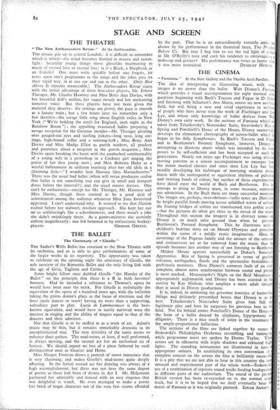THE CINEMA
Fantasia." At the New Gallery and the Marble Arch Pavilion. THE idea of interpreting or illustrating music with visual images is no newer than the ballet. Walt Disney's Famang which provides a visual accompaniment for eight musical con', positions beginning with Bach's Toccata and Fugue in D Mina and finishing with Schubert's Ave Maria, enters no new aestherk field, but will bring a new and vivid experience to million' of people who have never seen the work of Fischinger and La Lye, and whose only knowledge of ballet derives from Walt Disney's own early work. In the sections of Fantasia which are taken from Tchaikovsky's Nutcracker Suite, Stravinsky's Rite el Spring and Ponchielli's Dance of the Hours, Disney successfully develops the elementary choreography of screen-ballet which Is began in his Silly Symphonies. In Bach's Toccata and Fuge and in Beethoven's Pastoral Symphony, however, Disney 4 attempting to illustrate music which was intended by its coin posers to be self-sufficient and has been accepted as such far generations. Nearly ten years ago Fischinger was using abstraa moving patterns as a screen accompaniment to excerpts free the minor musical classics and since then Len Lye has bee steadily developing his technique of marrying modern dance. music with the contrapuntal or equivalent rhythms of pulsating and twisting bands of colour, but neither of these experimenten have dared enter the world of Bach and Beethoven. For his courage in doing so Disney must, in some measure, command our admiration. In the Bach there are many successful moments The images are, perhaps, over-obvious—'cello notes are illustrated by bright parallel bands moving across solidified waves of colour the floating bridges of violins are transformed into gothic archa —but the pictures do often get close to the mood of the mtte Throughout this section the imagery is in abstract terms and Disney is on much safer ground than when he presents Beethoven's Pastoral Symphony. This he illustrates with children's bedtime story set on Mount Olympus and presented within the terms of a mildly erotic imagination. Here cavortings of the Pegasus family and the amours of the centaur and centauresses are so far removed from the music that th episode becomes just another way of not listening to Beethoven Mickey Mouse appears successfully as Dukas's Sorcerer' Apprentice. Rite of Spring is presented in terms of gushing volcanos, earthquakes, floods and the spectacular bestialities of prehistoric monsters. Here Disney's common fault of an mn complete, almost naive synchronism between sound and picture is most marked. Moussorgsky's Night on the Bald Mountain is appropriately nightmarish and Disney has been assisted in this section by Kay Nielson, who employs a more adult image than is usual in Disney productions.
It is, indeed, in animating the gossamer traceries of butterffi foliage and delicately personified beasts that Disney is at his best. Tchaikovsky's Nutcracker Suite gives him full and legitimate play and here he surpasses his previous best in tilt kind. Not far behind comes Ponchielli's Dance of the Hours the form of a ballet danced by elephants, hippopotami alligators. There is a nice touch of satire in the treatment the amply-proportioned ballerinas.
The sections of the films are linked together by scenes Stokowski's Philadelphia Orchestra assembling and tuning-0 while programme notes are spoken by Deems Taylor. Th scenes are in silhouette with triple shadows and 'coloured hi lights. The sounding instruments are illuminated in turn appropriate colours. In establishing its own convention of complete concert on the screen the film is brilliantly success It is a pity that we are not able to hear in this country the an unusual and experimental part of the whole work—Stokowsla use of a combination of separate sound tracks feeding loudspeake in different parts of the auditorium. The sound of the prese British version has been re-recorded on to the normal sin_ track, but it is to be hoped that we shall eventually hear music of Fantasia as it was originally planned. EDGAR AxnEy.


























 Previous page
Previous page